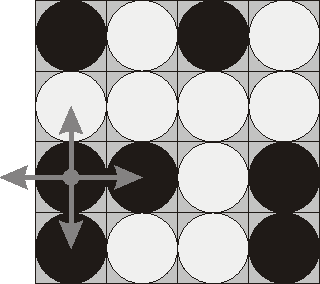Flip Game
Description
Flip game is played on a rectangular 4x4 field with two-sided pieces placed on each of its 16 squares. One side of each piece is white and the other one is black and each piece is lying either it's black or white side up. Each round you flip 3 to 5 pieces, thus changing the color of their upper side from black to white and vice versa. The pieces to be flipped are chosen every round according to the following rules:
 Consider the following position as an example:
Consider the following position as an example:
bwbw
wwww
bbwb
bwwb
Here "b" denotes pieces lying their black side up and "w" denotes pieces lying their white side up. If we choose to flip the 1st piece from the 3rd row (this choice is shown at the picture), then the field will become:
bwbw
bwww
wwwb
wwwb
The goal of the game is to flip either all pieces white side up or all pieces black side up. You are to write a program that will search for the minimum number of rounds needed to achieve this goal.
- Choose any one of the 16 pieces.
- Flip the chosen piece and also all adjacent pieces to the left, to the right, to the top, and to the bottom of the chosen piece (if there are any).
 Consider the following position as an example:
Consider the following position as an example: bwbw
wwww
bbwb
bwwb
Here "b" denotes pieces lying their black side up and "w" denotes pieces lying their white side up. If we choose to flip the 1st piece from the 3rd row (this choice is shown at the picture), then the field will become:
bwbw
bwww
wwwb
wwwb
The goal of the game is to flip either all pieces white side up or all pieces black side up. You are to write a program that will search for the minimum number of rounds needed to achieve this goal.
Input
The input consists of 4 lines with 4 characters "w" or "b" each that denote game field position.
Output
Write to the output file a single integer number - the minimum number of rounds needed to achieve the goal of the game from the given position. If the goal is initially achieved, then write 0. If it's impossible to achieve the goal, then write the word "Impossible" (without quotes).
Sample Input
bwwb bbwb bwwb bwww
Sample Output
4
思路:对于每个棋子有翻和不翻两种状态,翻奇数次等于翻1次,翻偶数次等于翻0次,因此16个棋子就有2^16种翻转的状态,枚举每个状态得到最小解。可以事先将翻转每个棋子后对应的状态保存起来。
AC代码(递归版):
1 #include<iostream> 2 #include<cstdio> 3 using namespace std; 4 char s[5][5]; 5 int st[16], ans = 17, all = 0; 6 int status[16]={0xC800, 0xE400, 0x7200, 0x3100, 7 0x8C80, 0x4E40, 0x2720, 0x1310, 8 0x08C8, 0X04E4, 0X0272, 0X0131, 9 0X008C, 0X004E, 0X0027, 0X0013}; 10 void dfs(int id, int steps){ 11 if(steps >= ans) return; 12 if(id >= 16){ 13 if(all == 0 || all == 65535) ans = steps; 14 return; 15 } 16 dfs(id+1, steps); 17 all ^= status[id]; 18 dfs(id+1, steps+1); 19 all ^= status[id]; 20 } 21 int main(){ 23 scanf("%s%s%s%s", s[3], s[2], s[1], s[0]); 24 for(int i = 0;i < 4;i ++) 25 for(int j = 0;j < 4;j ++) 26 if(s[i][j] == 'b') all ^= 1 << (i * 4 + j); 27 dfs(0, 0); 28 ans > 16 ? printf("Impossible") : printf("%d ", ans); 29 return 0; 30 }
下面是非递归的,测试的数据结果都一样,就是不给过,=!_!=。
1 #include<iostream> 2 #include<cstdio> 3 using namespace std; 4 int status[16]={0xC800, 0xE400, 0x7200, 0x3100, 5 0x8C80, 0x4E40, 0x2720, 0x1310, 6 0x08C8, 0X04E4, 0X0272, 0X0131, 7 0X008C, 0X004E, 0X0027, 0X0013 8 }; 9 int main(){ 10 char s[5][5];12 while(~scanf("%s%s%s%s", s[3], s[2], s[1], s[0])){ 13 int ans = 17, all = 0, temp, pt[20]; 14 for(int i = 0;i < 4;i ++) 15 for(int j = 0;j < 4;j ++) 16 if(s[i][j] == 'b') all ^= 1 << (i * 4 + j); 17 for(int i = 0;i < 1 << 16;i ++){ 18 int k = 0, temp = all; 19 for(int j = 0;j < 16;j ++) 20 if(i & (1 << j)) pt[k++] = j; 21 for(int j = 0;j < k;j ++) all ^= status[15-pt[j]]; 22 if(all == 0 || all == 65535) ans = min(ans, k); 23 else all = temp; 24 } 25 ans > 16 ? printf("Impossible") : printf("%d ", ans); 26 } 27 return 0; 28 }